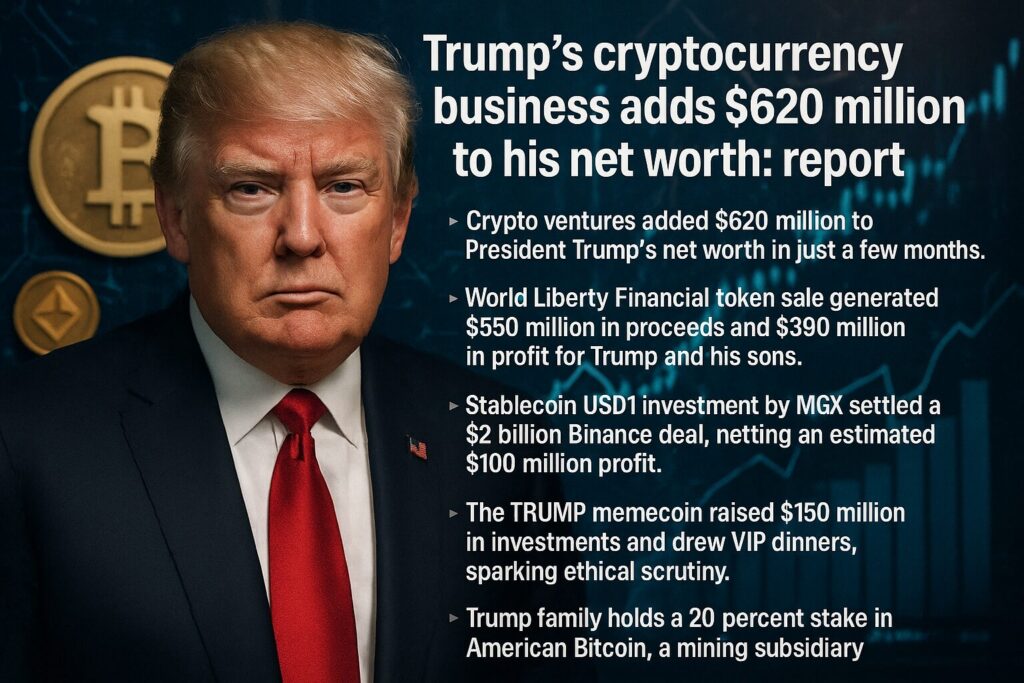
Main Points:
- Crypto ventures added $620 million to President Trump’s net worth in just a few months.
- World Liberty Financial token sale generated $550 million in proceeds and $390 million in profit for Trump and his sons.
- Stablecoin USD1 investment by MGX settled a $2 billion Binance deal, netting an estimated $100 million profit.
- The TRUMP memecoin raised $150 million in investments and drew VIP dinners, sparking ethical scrutiny.
- Trump family holds a 20 percent stake in American Bitcoin, a mining subsidiary that raised $220 million in June 2025.
- Broader crypto trends: record inflows into Bitcoin ETFs and growing institutional adoption underscore digital assets’ mainstream shift.
- Regulatory and ethical challenges: Congress is considering bills to ban digital asset dealings by senior officials amid conflict-of-interest concerns.
1. Crypto Surge in Presidential Wealth
When President Trump assumed office for a second term, his reported net worth hovered around $6.5 billion. Yet, behind the stable headline figure lies a seismic shift: in a span of months ending June 2025, his family’s cryptocurrency-related ventures delivered at least $620 million of additional wealth. This quantum leap, accounting for roughly 9 percent of his total assets, marks the first time digital assets have made up a significant slice of his portfolio.
Despite Trump’s historical reliance on media ventures and real estate—hotels, golf courses, and his social platform Truth Social—these new revenue streams have outpaced traditional income at a speed never before seen in his business empire. The Bloomberg Billionaires Index attributes much of this windfall to token sales, governance tokens, and strategic stablecoin investments, all under the umbrella of family-backed entities.
2. Token Sales and Governance Tokens
Central to the crypto windfall is World Liberty Financial (WLF), a venture backed by Trump family members. The company’s public token sale amassed $550 million, from which the president and his three sons took home $390 million in direct profit. Additionally, they hold over $2 billion in WLF’s governance tokens, illustrating their long-term commitment to shaping the project’s trajectory.
These governance tokens not only grant voting rights within the WLF ecosystem but also confer significant economic upside as the platform grows. Governance models in DeFi (decentralized finance) have become a powerful tool for investors to wield influence, and the Trump family has strategically positioned itself at the heart of this governance revolution.
3. Stablecoin Investments and Exchange Deals
Another pillar of the crypto enrichment is USD1, a stablecoin issued by World Liberty Financial. In June 2025, Abu Dhabi–based MGX settled a $2 billion investment on the Binance exchange using USD1, generating an estimated $100 million profit for WLF.
The use of stablecoins for high-value settlements exemplifies a broader industry shift: digital dollars are increasingly favored for their speed, cost efficiency, and resistance to censorship. As major exchanges and institutional players integrate stablecoins more deeply into their operations, issuers like WLF can monetize vast transactional flows.
4. The $TRUMP Memecoin Phenomenon
In January 2025, Trump launched $TRUMP, a memecoin on the Solana blockchain. The Initial Coin Offering (ICO) released 200 million tokens, with the remaining 800 million held by Trump-controlled entities. Within a day, the market valuation surpassed $27 billion, briefly reflecting a theoretical $20 billion worth of tokens in Trump’s vault.
To reward early adopters, Trump hosted a VIP dinner and facility tour for the top 220 token holders, which drew fierce criticism from ethics experts and lawmakers. The event was labeled “one of the most blatant and appalling instances of selling access to the presidency” by watchdogs and sparked legislative proposals to curb official involvement in digital asset promotions.
5. Mining Ventures with American Bitcoin
Beyond tokens, the Trump family holds a 20 percent stake in American Bitcoin, a subsidiary of mining firm HUT 8. In June 2025, the company raised $220 million to expand equipment and purchase Bitcoin directly. With plans to merge and list alongside Griffon Digital Mining, this venture positions the family to benefit from both hardware revenues and the rising value of mined BTC.
Crypto mining remains an energy-intensive but potentially lucrative segment. As Bitcoin mining rewards halve and competition intensifies, strategic capital injections can tilt the scales toward profitable operations—a calculus clearly understood by American Bitcoin’s backers.
6. Regulatory and Ethical Challenges
Trump’s rapid crypto ascent has not gone unnoticed on Capitol Hill. Multiple bills have been introduced to prohibit senior federal officials and their families from trading or promoting digital assets, citing conflict-of-interest and national security concerns.
In early July 2025, Senator Jeff Merkley proposed an amendment during budget negotiations to specifically address Trump’s crypto dealings, highlighting the risk of mixing official duties with personal financial gain. However, partisan divides have thus far blocked any sweeping reform, leaving the industry and political norms in a state of limbo.
7. Broader Market Trends: Institutional Adoption
The Trump family’s embrace of crypto reflects a massive institutional pivot toward digital assets. In May 2025, US Bitcoin ETFs drew over $9 billion in fresh inflows, led by BlackRock’s iShares Bitcoin Trust (IBIT), which saw more than $6.35 billion in a single month—its highest since debut. Furthermore, IBIT now generates $187.2 million in annual fees—surpassing the flagship BlackRock S&P 500 ETF—demonstrating investors’ surging appetite for regulated Bitcoin exposure.
Meanwhile, progress on stablecoin legislation and President Trump’s stated support for a Strategic Bitcoin Reserve have further catalyzed confidence, pushing Bitcoin to record highs near $110,000 in late June 2025.
Conclusion
Donald Trump’s $620 million crypto windfall underscores a transformative era where digital assets can rival—and in some cases outpace—established industries in wealth creation. From token sales and memecoins to stablecoin settlements and mining ventures, the Trump family’s multifaceted strategy exemplifies how political influence and blockchain innovation intersect.
As institutional capital pours into Bitcoin ETFs and governments scramble to craft crypto regulations, the space will continue evolving at breakneck speed. For investors and blockchain practitioners, Trump’s story serves as both a cautionary tale of ethical risk and an illustration of the immense opportunity embedded in digital finance.

